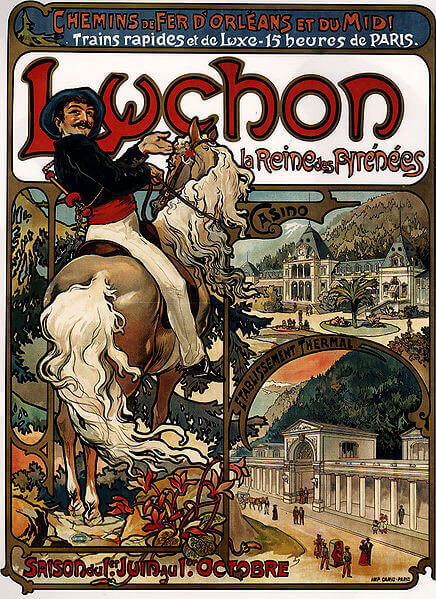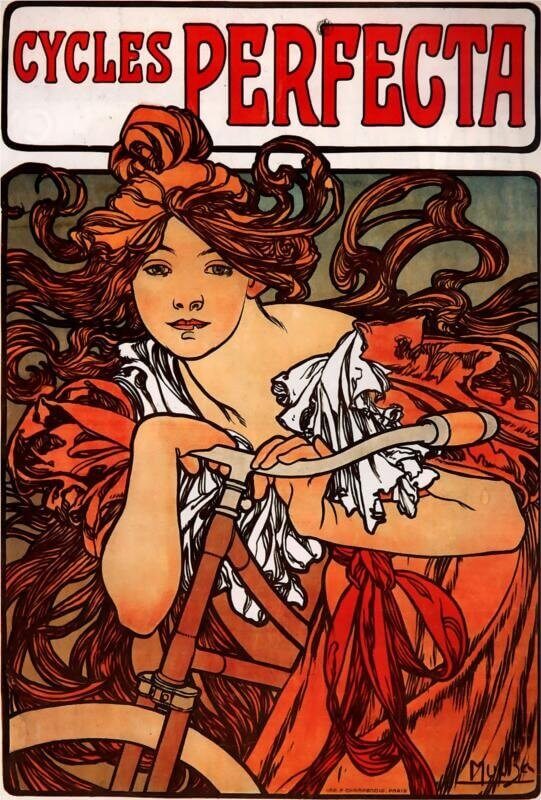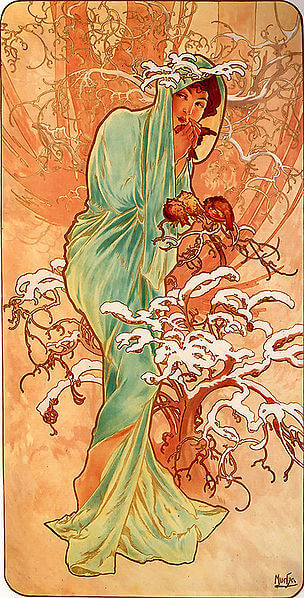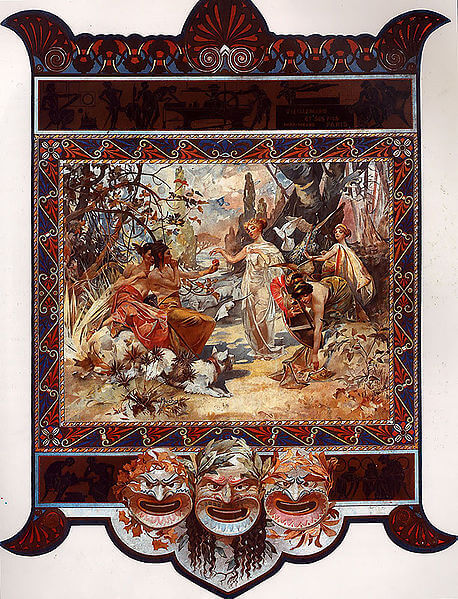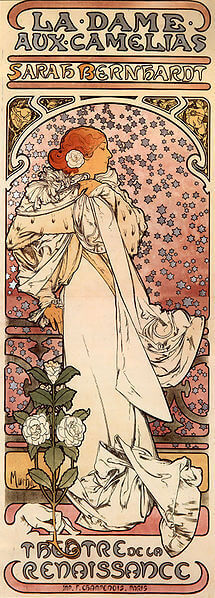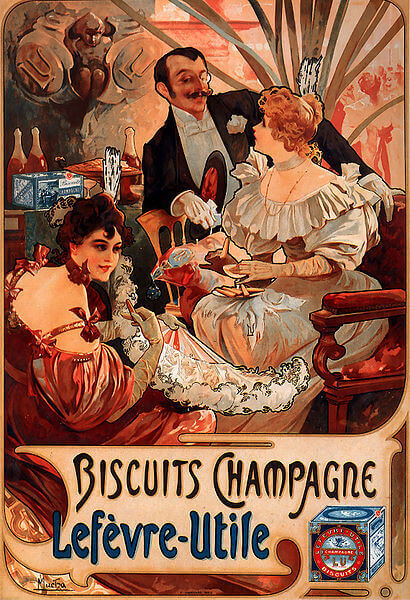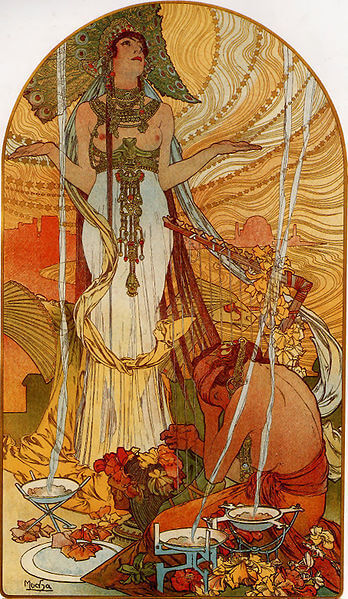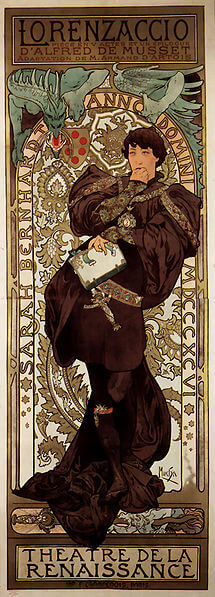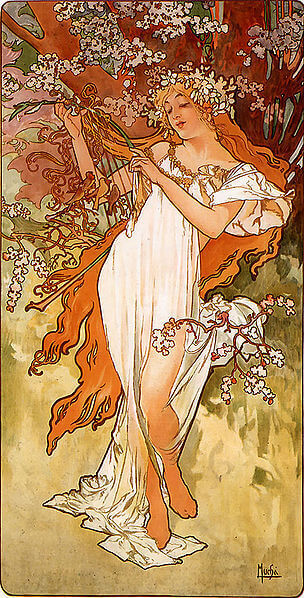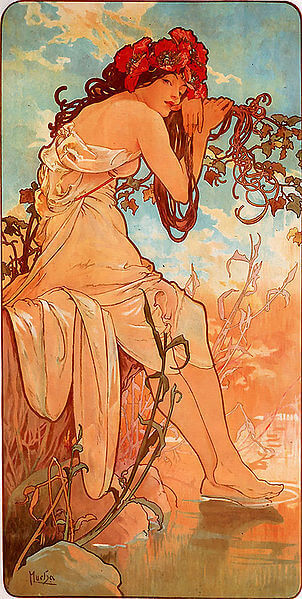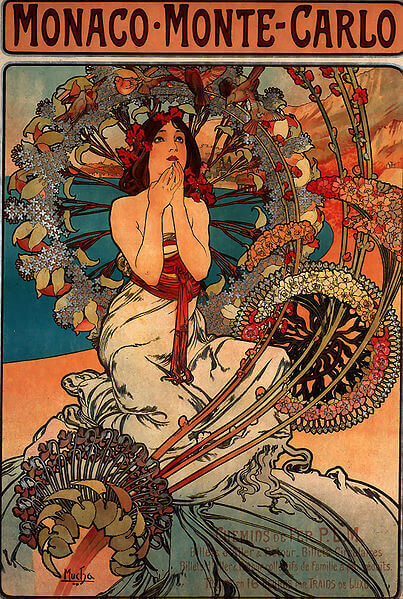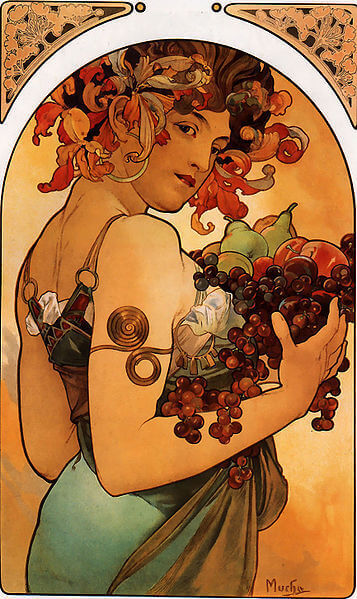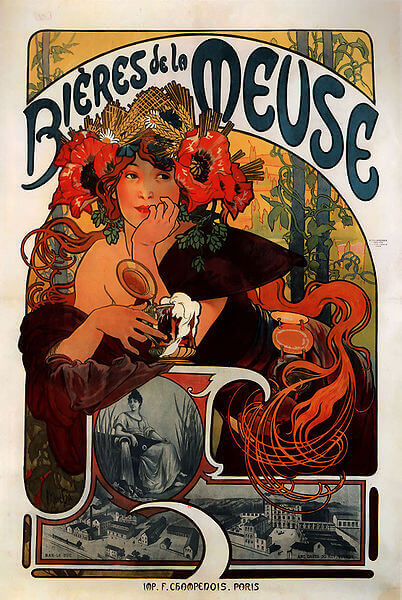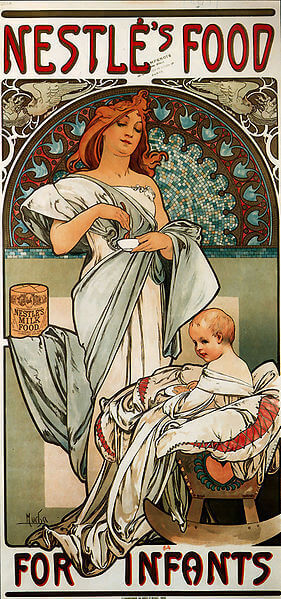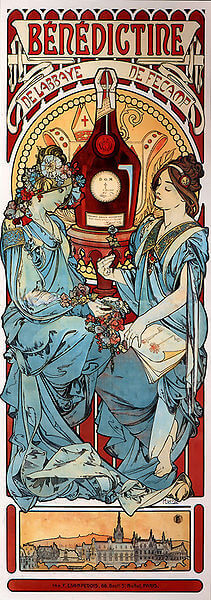Who is Alphonse Mucha? The life and work of Alphonse Mucha, Czech Art Nouveau artist and decoration artist.
Alfons Maria Mucha (July 24, 1860 – July 14, 1939), known as Alphonse Mucha, was a Czech Art Nouveau painter and decorative artist, known for his distinctive style. He produced many paintings, illustrations, advertisements, postcards and designs.
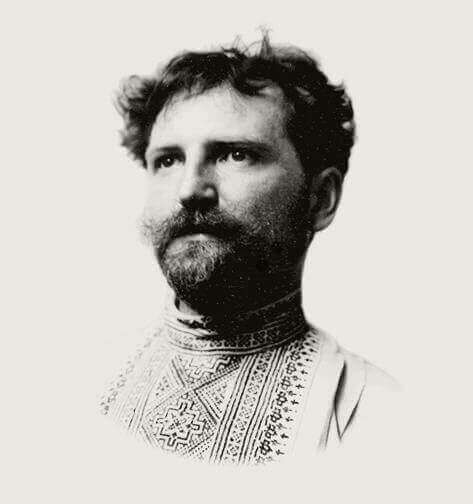
First years
Alphonse Maria Mucha was born in the city of Ivančice, Moravia (now a region of the Czech Republic). In 1871, Alphonse Mucha became a chorister at the Cathedral of St. Peter and Paul, Brno, where he received his secondary education. It is there where he had his first revelation, in the face of the richness of Baroque art. During the four years of studying there, he became friends with Leoš Janáček, who would become the best Czech composer of his generation.
Although his singing skills allowed him to continue his education through high school, now known as Gymnázium Brno, třída Kapitána Jaroše 14, in the capital of Moravia, Brno, drawing had been his main hobby since childhood. He worked in decorative painting works in Moravia, mainly painting theatrical stages. In 1879, he moved to Vienna to work for a major Viennese theater design company, while informally increasing his artistic education. When a fire destroyed his employer’s business during 1881, he returned to Moravia to do decorative painting and independent portraits. Count Karl Khuen of Mikulov hired Alphonse Mucha to decorate the Hrušovany Emmahof Castle with murals and was so impressed that he agreed to sponsor Alphonse Mucha’s formal training at the Academy of Fine Arts in Munich.
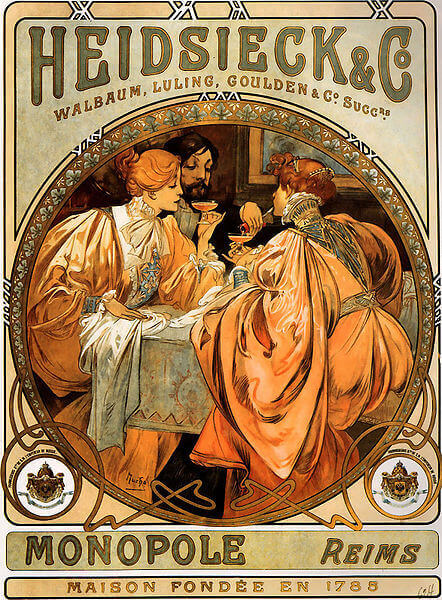
Alphonse Mucha moved to Paris in 1887 and continued his studies at the Académie Julian and the Académie Colarossi. In addition to his studies, he worked in the production of magazine and publicity illustrations. About Christmas of 1894, Alphonse Mucha went to a printing press where there was a sudden and unexpected need for a new advertising poster of a work by Sarah Bernhardt, the most famous actress in Paris, at the Théâtre de la Renaissance on Boulevard Saint-Martin . Alphonse Mucha offered to produce a lithographed poster in two weeks, and on January 1, 1895, the announcement of the work Gismonda by Victorien Sardou was published in the city, where it attracted a lot of attention.
Bernhardt was so pleased with the success of this first poster that he started a six-year contract with Alphonse Mucha.
Alphonse Mucha produced a barrage of paintings, posters, advertisements and book illustrations, as well as jewelry designs, carpets, wallpaper and theater sets in what was initially called The Mucha Style, but became known as Art Nouveau (in French as “new art.”) Alphonse Mucha’s works often featured beautiful young women in flowing, neoclassical robes, often surrounded by lush flowers that sometimes formed halos behind their heads, in contrast to contemporary poster makers. , he used pale pastel colors.
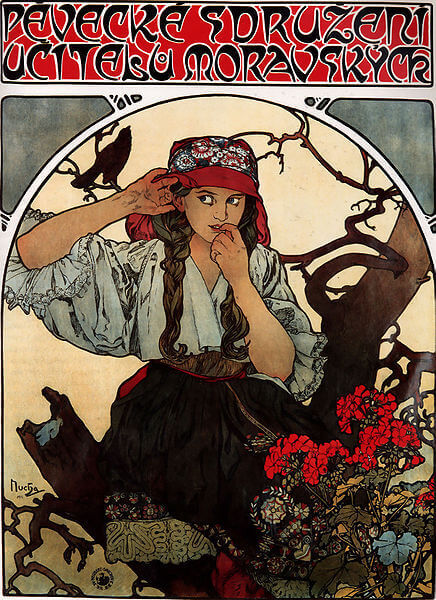
Mucha’s style was exhibited internationally by the Universal Exposition of 1900 in Paris, of which Mucha said: “I think it contributed to bring aesthetic values closer to art and craftsmanship”.
He decorated the Bosnia and Herzegovina Pavilion and collaborated with the decoration of the Austrian Pavilion. His Art Nouveau style was often imitated. The Art Nouveau style, however, was one that Mucha tried to disassociate himself from throughout his life; he always insisted that, instead of maintaining any fashionable stylistic form, his paintings were entirely a product of himself and Czech art. He declared that art existed only to communicate a spiritual message, and nothing more; hence his frustration over the fame he acquired with his commercial art, when he most wanted to concentrate on more artistic projects.
Marriage
Mucha married Maruška (Marie / Maria) Chytilová on June 10, 1906, in Prague. The couple visited the United States from 1906 to 1910, during which time their daughter, Jaroslava, was born in New York City. They also had a son, Jiří, (born on March 12, 1915 in Prague, died on April 5, 1991 in Prague) who later became a journalist, writer, screenwriter, author of autobiographical novels and studies of his works.
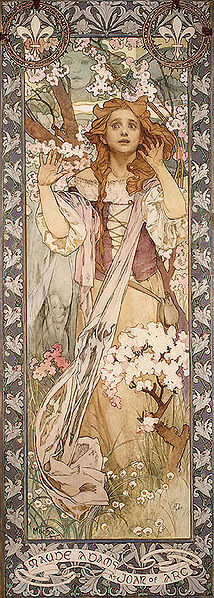
In the United States, Mucha hoped to earn money to finance his nationalist projects to prove to the Czechs that he had not “sold out.” He was assisted by the millionaire Charles R. Crane, who used his fortune to help promote revolutions and, after meeting Thomas Masaryk, Slavic nationalism. Alphonse and his family returned to the Czech lands and settled in Prague, where he decorated the Fine Arts Theater, contributed their time and talent to create the murals in the Mayor’s Office in the Municipal House, and other places of interest in the city . When Czechoslovakia gained its independence after the First World War, Mucha designed the new postage stamps, bank notes and other government documents for the new state.
Le Pater
Mucha considered his publication Le Pater as his printed masterpiece, and referred to it in the New York Sun of January 5, 1900 as what he had “put soul into it”. Printed on December 20, 1899, Le Pater was Mucha’s occult examination on the subjects of The Lord’s Prayer and only 510 copies were produced.
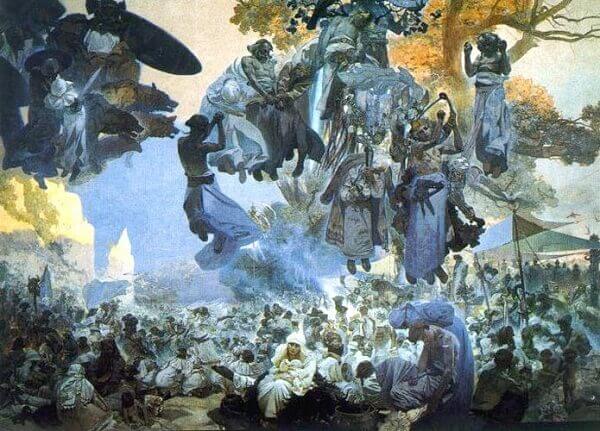
The Slavic epic
Mucha spent many years working on what he considered his masterpiece of the art of life, The Slavic Epic (Slovanská epopej), a series of twenty huge paintings depicting the history of the Czech and Slavic people in general, bestowed upon the city of Prague in 1928. I had wanted to complete a series like this, a celebration of Slavic history, since I was young. From 1963 to 2012, the series was on display at the Moravský Krumlov castle in the South Moravia region of the Czech Republic. Since 2012, the series has been on display at the Veletržní Palace of the National Gallery in Prague.
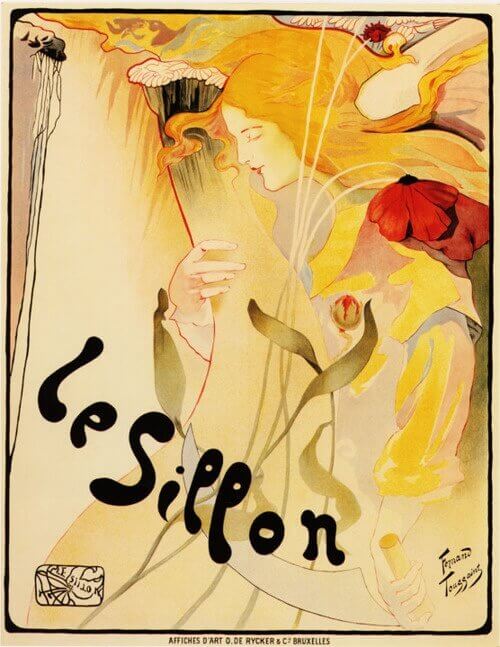
Death
The rising tide of fascism in the late 1930s led to Mucha’s works and his Slavic nationalism was denounced in the press as “reactionary.” Mucha’s Slavic nationalism and Jewish roots made it a major target of the Gestapo during the Nazi occupation. When the German troops moved to Czechoslovakia during the spring of 1939, Mucha was one of the first people arrested by the Gestapo. During his interrogation, the aging artist became ill with pneumonia. Although he finally freed himself, he may have been weakened by this event. He died in Prague on July 14, 1939, due to a lung infection, and was buried there in the cemetery of Vyšehrad.
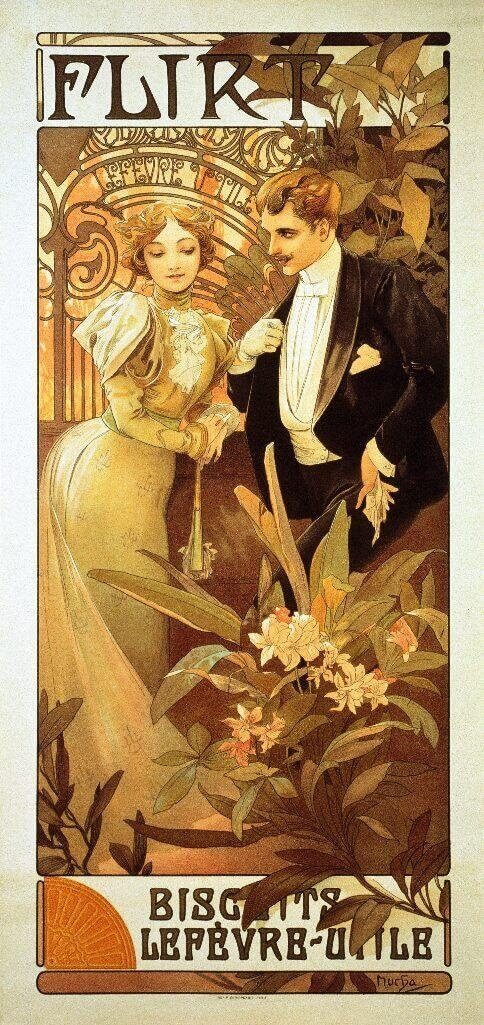
Legacy
Although today enjoys great popularity, at the time he died, Mucha’s style was considered obsolete. His son, the author Jiří Mucha, devoted a large part of his life to writing about him and drawing attention to his work of art. In his own country, the new authorities were not interested in Mucha. The Slavic epic was shot and stored for twenty-five years before being shown at Moravský Krumlov, and a Mucha museum was opened in Prague, led by his grandson John Mucha.
Mucha’s work has continued to experience periodic revivals of interest to illustrators and artists. The interest in Mucha’s distinctive style experienced a strong resurgence during the 1960s (with a general interest in Art Nouveau) and is particularly evident in the psychedelic posters of Hapshash and The Colored Coat, the collective name of British artists Michael English and Nigel Waymouth, and Bob Masse.
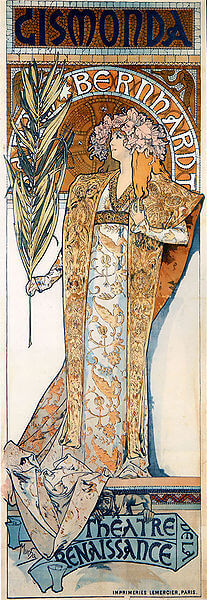
Mucha’s work is a well-known influence for painter Stuckist Paul Harvey.
The band Soilent Green used an image of Mucha for the cover of their album Sewn Mouth Secrets.
At the request of the band, Metromedia bought the rights to use the painting of Mucha Zodiac on the cover of their debut album “Gypsy”, which was released in the fall of 1970 by the band Gypsy. It was also used as a box on the cover of their second album “In The Garden”, which was released in 1971 but did not achieve much promotion.
One of Mucha’s paintings, Quo Vadis or alternatively Petronius and Eunice, was the subject of a legal dispute in 1986. The Richard Posner trial describes parts of Mucha’s life and work biographically.
Among his many other achievements, Mucha was also the restorer of Czech Freemasonry.
One of Mucha’s largest collections of works is in possession of the former number one in the world. 1 professional tennis player Ivan Lendl, who started collecting his works when he met Jiří Mucha in 1982. His collection was publicly exhibited for the first time in 2013 in Prague.
Alphonse Mucha Selected Works, Paintings
